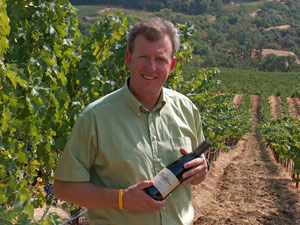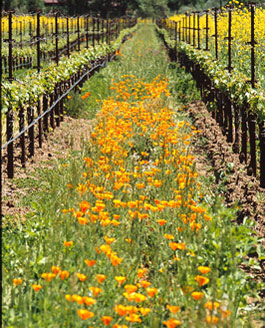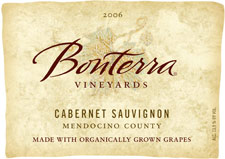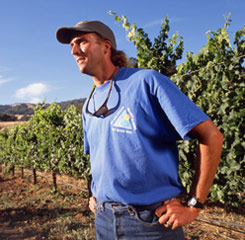

Bonterra Vineyards winemaker Bob Blue is a two decade veteran of organic wine production.
Bonterra Vineyards: Ground Zero
for Organic Grapegrowing
by
Eleanor & Ray Heald
July 4, 2008
Appellation America: Some consumers are confused by jargon phrases referring to organic grape farming. What is the current nomenclature used for this type of farming?
Bob Blue (BB): Wines with the phrase “made with (or from) organically grown grapes” on the main label are produced at a certified winery, under National Organic Program regulations and may have added sulfites, but at levels less than 100 parts per million (ppm) total and 35ppm free to prevent oxidation and ensure shelf stability.
Grapes that are considered organically grown are in accordance with the California Health and Safety Code, Sec. 26569 and are certified by California Certified Organic Farmers (CCOF), a third-party inspection and endorsement organization with exacting standards. The certifier must be listed on a back label. Certification requires a three-year period of regular inspection to ensure that regulations are being met.
AA: What are the elements of certification today?
BB: Organically-grown grapes are produced without the use of artificial fertilizers or synthetic chemicals, which include pesticides, fungicides, herbicides, soil fumigants and growth-regulating
Cover crops in McNab Vineyard sustain ecological balance – and beauty - in organic vineyards.hormones. Emphasis is put on building a living soil and an environment encouraging beneficial organisms in the vineyard, establishing a natural pest-predator balance.
AA: How does an organically certified winery like Bonterra differ from another wine producer who only practices organically-certified grapegrowing?
BB: What that producer cannot do is put the “made with” wording on the front label. On the back label, they are allowed to state the percentage of organically-grown grapes. The concept there is similar to organic produce that is not brought directly to market by the organic farmer, but is sold to an uncertified handler. The product is not really changed, but to continue the organic link, the handlers must also be certified. There must be product integrity every step of the way.
AA: Consumers encounter the expression “organic wines.” What does this mean?
BB: Wines that are labeled “organic” follow a similar grape farming regime as wines made from organically-grown grapes. However, no additional sulfur dioxide is permitted during fermentation, despite the fact that some sulfites are produced naturally during the fermentation period. Organic wines are made at a certified winery under National Organic Program regulation and no sulfites may be added. For reasons of preventing oxidation and bottled wine stability in the marketplace, Bonterra has sulfite levels below the certifiable amount.
Any use of the term “organic” on a wine label or in advertising of wine must comply with the United States Department of Agriculture's (USDA) National Organic Program rules as interpreted by the USDA.
AA: What is the location of Bonterra’s certified organically-farmed vineyards?
BB: In Mendocino County AVA, Bonterra Vineyards owns or leases more than 1,000 certified acres of organically-farmed grapes. More than 500 additional certified organic vineyards, farmed by independent growers in Mendocino County, also supply Bonterra with organically-grown grapes. We source some certified organic Sauvignon Blanc and Viognier from Lake County AVA. Everything that Bonterra does is certified organic.
AA: In what year did Bonterra become certified by California Certified Organic Farmers (CCOF)?
BB: Bonterra started farming organically in 1987 and the first vineyards were certified in 1990. In those days, though, we could not certify the winery, and could not until 1998.
AA: What are the most important practices in Bonterra’s organic farming?
BB: Whenever someone chooses to farm, they impact the native environment. We strive to minimize the impacts. We start by soil management to strengthen the vines with addition of organic matter from decomposing winter cover crops, water and minerals. When organic matter increases so do microbial populations, which break down organic matter into soil-enriching humus.
 Healthy grape vines resist disease pressures from insects, and pest populations are checked by predator pests. To increase the population of predator species, we create an attractive environment by planting cover crops and flowers that are part of the predator species diet.
Healthy grape vines resist disease pressures from insects, and pest populations are checked by predator pests. To increase the population of predator species, we create an attractive environment by planting cover crops and flowers that are part of the predator species diet.
AA: How are vineyard weeds controlled?
BB: With low impact mowing and hand-hoeing.
AA: With what products are vineyards sprayed?
BB: To prevent mildew, we apply organic sulfur and occasionally use plant extracts for insect control. Fungal diseases such as mildew and Botrytis are controlled by vineyard practices that maximize air flow in the canopy and fruit zone and the use of stylet oils. We work in the prevention mode. We have to. With organic farming, there are no quick fixes.
AA: With The McNab ($45 and blend of 47 percent Merlot, 36 percent Cabernet Sauvignon and 17 percent Petite Sirah), Bonterra introduces the consumer to the concept of a biodynamically-farmed vineyard, certified by the Demeter Association, or what might be called holistic farming. How does this differ from the organic practices at Bonterra’s other ranches and vineyards?
BB: Biodynamics does much of what Bonterra already does for pest and disease management and cover crops, but extends it to the development and management of our vineyards as a whole. We’ve brought in livestock, such as sheep and chickens, to eat cover crops in winter when vines are dormant. After bud break at the beginning of the growing
David Koball, Bonterra’s Director of Mendocino County Vineyards.season, animals maintain vineyard periphery and the face of the property dam. There’s also a greater diversification of plants, including olive trees, persimmons, apples and peaches.
David Koball, Bonterra’s Director of Mendocino County Vineyards, also uses two field sprays, one is cow manure made into a tea and sprayed on the ground to help stimulate organic matter decomposition. The other is ground up silica quartz sprayed on foliage to stimulate photosynthesis. A number of fermented herbs are made into a tincture and sprayed onto the compost.
AA: Why are you blending grapes from two AVAs for Sauvignon Blanc?
Bob Blue (BB): Wines with the phrase “made with (or from) organically grown grapes” on the main label are produced at a certified winery, under National Organic Program regulations and may have added sulfites, but at levels less than 100 parts per million (ppm) total and 35ppm free to prevent oxidation and ensure shelf stability.
Grapes that are considered organically grown are in accordance with the California Health and Safety Code, Sec. 26569 and are certified by California Certified Organic Farmers (CCOF), a third-party inspection and endorsement organization with exacting standards. The certifier must be listed on a back label. Certification requires a three-year period of regular inspection to ensure that regulations are being met.
AA: What are the elements of certification today?
BB: Organically-grown grapes are produced without the use of artificial fertilizers or synthetic chemicals, which include pesticides, fungicides, herbicides, soil fumigants and growth-regulating

Cover crops in McNab Vineyard sustain ecological balance – and beauty - in organic vineyards.
AA: How does an organically certified winery like Bonterra differ from another wine producer who only practices organically-certified grapegrowing?
BB: What that producer cannot do is put the “made with” wording on the front label. On the back label, they are allowed to state the percentage of organically-grown grapes. The concept there is similar to organic produce that is not brought directly to market by the organic farmer, but is sold to an uncertified handler. The product is not really changed, but to continue the organic link, the handlers must also be certified. There must be product integrity every step of the way.
AA: Consumers encounter the expression “organic wines.” What does this mean?
BB: Wines that are labeled “organic” follow a similar grape farming regime as wines made from organically-grown grapes. However, no additional sulfur dioxide is permitted during fermentation, despite the fact that some sulfites are produced naturally during the fermentation period. Organic wines are made at a certified winery under National Organic Program regulation and no sulfites may be added. For reasons of preventing oxidation and bottled wine stability in the marketplace, Bonterra has sulfite levels below the certifiable amount.
Any use of the term “organic” on a wine label or in advertising of wine must comply with the United States Department of Agriculture's (USDA) National Organic Program rules as interpreted by the USDA.
AA: What is the location of Bonterra’s certified organically-farmed vineyards?
BB: In Mendocino County AVA, Bonterra Vineyards owns or leases more than 1,000 certified acres of organically-farmed grapes. More than 500 additional certified organic vineyards, farmed by independent growers in Mendocino County, also supply Bonterra with organically-grown grapes. We source some certified organic Sauvignon Blanc and Viognier from Lake County AVA. Everything that Bonterra does is certified organic.
AA: In what year did Bonterra become certified by California Certified Organic Farmers (CCOF)?
BB: Bonterra started farming organically in 1987 and the first vineyards were certified in 1990. In those days, though, we could not certify the winery, and could not until 1998.
AA: What are the most important practices in Bonterra’s organic farming?
BB: Whenever someone chooses to farm, they impact the native environment. We strive to minimize the impacts. We start by soil management to strengthen the vines with addition of organic matter from decomposing winter cover crops, water and minerals. When organic matter increases so do microbial populations, which break down organic matter into soil-enriching humus.
 Healthy grape vines resist disease pressures from insects, and pest populations are checked by predator pests. To increase the population of predator species, we create an attractive environment by planting cover crops and flowers that are part of the predator species diet.
Healthy grape vines resist disease pressures from insects, and pest populations are checked by predator pests. To increase the population of predator species, we create an attractive environment by planting cover crops and flowers that are part of the predator species diet.
AA: How are vineyard weeds controlled?
BB: With low impact mowing and hand-hoeing.
AA: With what products are vineyards sprayed?
BB: To prevent mildew, we apply organic sulfur and occasionally use plant extracts for insect control. Fungal diseases such as mildew and Botrytis are controlled by vineyard practices that maximize air flow in the canopy and fruit zone and the use of stylet oils. We work in the prevention mode. We have to. With organic farming, there are no quick fixes.
AA: With The McNab ($45 and blend of 47 percent Merlot, 36 percent Cabernet Sauvignon and 17 percent Petite Sirah), Bonterra introduces the consumer to the concept of a biodynamically-farmed vineyard, certified by the Demeter Association, or what might be called holistic farming. How does this differ from the organic practices at Bonterra’s other ranches and vineyards?
BB: Biodynamics does much of what Bonterra already does for pest and disease management and cover crops, but extends it to the development and management of our vineyards as a whole. We’ve brought in livestock, such as sheep and chickens, to eat cover crops in winter when vines are dormant. After bud break at the beginning of the growing

David Koball, Bonterra’s Director of Mendocino County Vineyards.
David Koball, Bonterra’s Director of Mendocino County Vineyards, also uses two field sprays, one is cow manure made into a tea and sprayed on the ground to help stimulate organic matter decomposition. The other is ground up silica quartz sprayed on foliage to stimulate photosynthesis. A number of fermented herbs are made into a tincture and sprayed onto the compost.
AA: Why are you blending grapes from two AVAs for Sauvignon Blanc?










 READER FEEDBACK: To post your comments on this story,
READER FEEDBACK: To post your comments on this story,




